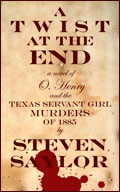A TWIST AT THE END |
|||||||||||||||||
A gripping, epic novel based on the serial murders that terrorized Austin, Texas, in 1885, and the scandalous trials that followed. Drawing on almost a decade of research, Steven recreates a forgotten era, and (with O. Henry as his hero) finds a solution to one of America’s bloodiest and most baffling series of crimes — perhaps the first recorded serial murders in U.S. history. “Saylor, who has set several previous mysteries in ancient Rome, has a knack for doing research and presenting the results with panache...The facts are certainly irresistible: in the 1880s, a series of grisly murder-rapes plagued Austin...Add to the mix the fact that O. Henry lived in Austin at the time and was tried for embezzlement, and you have everything you need for a riveting historical mystery...It’s all fascinating and provocative, like a good O. Henry story.” (Liam Callanan, New York Times Book Review) “Steven Saylor’s inventive new novel puts a fictional spin on the real-life case of the Servant Girl Annihilators...O. Henry...who actually did live in Austin at the time of the murders, is a canny choice of hero. With his celebrated gift for surprise endings, O. Henry seems a natural gumshoe, perfectly attuned to the twists and turns of the crime story...Saylor, a veteran of the historical novel, navigates these rapids with confident skill...Better still, in the manner of O. Henry himself, he saves a cunning twist for the end.” (Daniel Stashower, Washington
Post Book World) “A gripping read...[and] a heck of a good love story with enough twists and turns — and not just at the end — to keep any reader guessing. A TWIST AT THE END is a well-constructed, old-fashioned yarn highly recommended for fans of the mystery, the literary novel and Texas history.” (Judyth Rigler, San Antonio Express-News) “In recent American fiction...mysteries...give us some of the most distinctive settings: David Lindsey’s Houston, James Lee Burke’s New Orleans, Lawrence Block’s New York, Steven Saylor’s Austin of 1885.” (Mary Willis Walker, Texas Monthly) “Saylor again brings his considerable talents to bear, creating a rich historical backdrop for a complex tangle of crime....a rich and fascinating story, all the more intriguing for its blend of fact and fiction.” (Irene Warner, Seattle Times) “Saylor loves the geography of the city, its streets, houses and buildings, and the diverse people who live in them. He delights in evoking period details of the interiors, furnishings, carpets and pictures, as well as placing the reader in the timeless natural landscape of hills and the winding Colorado River.” (Richard Dyer, San Jose Mercury News) “[Saylor] shows how a society that is founded on inequality and injustice can be a perfect hunting ground for the deranged.” (Times Literary Supplement) |
International Kindles
|
||||||||||||||||
|
A TWIST AT THE END is based on actual events. How did you first find out about these crimes? About eight years ago, on a visit home to Austin — I’m originally from Texas but I live mostly in California now — I came across a brief reference in a coffee table book called Austin: An Illustrated History. It was only a few lines in a year-by-year chronology. “Christmas Day, 1885: Austinites awake to discover two more women butchered to death, ending a series of nighttime murders in which eight victims, seven of them females, were killed. The murders were never solved.” I thought: A serial murder, in Austin, predating Jack the Ripper by two years? I had to know more. So the next day I headed for the archives at the Austin History Center and started going through the microfiche of old newspapers. When I found a headline that read “Blood! Blood! Blood!” I was hooked. I knew at that moment that I was going to write a novel about these killings, even though I had no idea how big the story actually was. As it turned out, the deeper I went into the research, the more amazing the story became — there’s not only murder, but police corruption, political hypocrisy, prostitution, and a scandalous trial. I had to do all my research from scratch, consulting original sources and court records, because there’s never been a history written about these murders and their aftermath. Why O. Henry for a hero? I chose Will Porter — who later became famous as the writer O. Henry — because he was a young man living in Austin at the time. It’s Porter who actually coined the phrase “Servant Girl Annihilators” to tag the unknown killers. His role in the book is largely fictional, but the details of the murders and the trials are absolutely true to history. So the novel is a mixture of fact and fiction? In the Author’s Note at the end of the book, I’ve tried to be very clear about what’s fact and what’s fiction and how the two are blended. What about Senate Bill 79, an act of the Texas Legislature which comes up in the novel? That’s a completely authentic detail that came out of the research. It surprises everyone — a move to enact affirmative action for women, in Texas, in 1885? And the arguments pro and con were exactly the same arguments that we hear today, more than a hundred years later. The politicians defending the status quo quoted from the Bible regarding a woman’s place, and warned that if such privileges were extended to women, the next thing you know, Blacks would demand the same thing! But the bill very nearly became law. The debates over Senate Bill 79 certainly exploded some of my preconceptions about Texas in 1885. Regarding women, you paint a vivid portrait of the sculptor Elisabet Ney, who had once been famous in Europe but in 1885 was living in obscurity in a Texas backwater the locals called Six-Shooter Junction. Was she a real person? Very real. Elisabet Ney is fairly well-known in the Texas because she was the state’s first world-class artist — she sculpted Sam Houston and Steven F. Austin for the State Capitol. Before she came to Texas, she was in great demand in Europe, where she sculpted some of the most famous men of the age, like Garibaldi and Bismarck and Ludwig the Mad. She plays a small but key role in the story. There are some other startling details - a scandal over racism and police violence that might remind readers of the Rodney King incident, and an incident at the big trial toward the end of the book that has echoes of “If it does not fit, you must acquit.” Again, these things came straight from the research. I wouldn’t have dared to make them up! A number of the Black characters encounter something called a dog ghost, which may or may not be a supernatural apparition. Where did that come from? We don’t know nearly as much as we should about the lives of Blacks in Texas at this time, but we’re very fortunate to have the research of a Black folklorist named J. Mason Brewer who taught at the University of Texas and who specialized in recording the oral folk tales of Blacks in Texas. The dog ghost figures largely in these tales — it has the appearance of a dog and may be quite fearsome, but it’s usually the ghost of a departed loved one who’s come back to help the living. And the Black people of Austin in 1885 need all the help they can get. Your previous novels have all been set in ancient Rome. What was it like to change your focus to Austin, Texas, in 1885? To be frank, at first I had misgivings. I felt I’d become rather spoiled, working with the incredible material and larger-than-life figures who tower over the crumbling Roman Republic of the 1st Century B.C. — Julius Caesar, Pompey, Cicero, Cleopatra. But as I delved deeper and deeper into the research, the story of the Servant Girl Annihilators and their victims loomed larger and larger to me, until it seemed truly epic. And yet we know so many intimate details about these people, how they lived and how they died. Sometimes the people in this book felt so close to me, I could almost touch them. |


